Related Research Articles
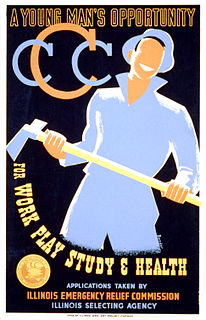
The Civilian Conservation Corps (CCC) was a voluntary government work relief program that ran from 1933 to 1942 in the United States for unemployed, unmarried men ages 18–25 and eventually expanded to ages 17–28. Robert Fechner was the first director of this agency, succeeded by James McEntee following Fechner's death. The CCC was a major part of President Franklin D. Roosevelt's New Deal that supplied manual labor jobs related to the conservation and development of natural resources in rural lands owned by federal, state, and local governments. The CCC was designed to supply jobs for young men and to relieve families who had difficulty finding jobs during the Great Depression in the United States. The largest enrollment at any one time was 300,000. Through the course of its nine years in operation, three million young men took part in the CCC, which provided them with shelter, clothing, and food, together with a wage of $30 per month.

Port Dickinson is a village in Broome County, New York, United States. The population was 1,641 at the 2010 census. It is part of the Binghamton Metropolitan Statistical Area.

Earlville is a village in Chenango County, New York, United States. The population was 872 at the 2010 census. The village is named after Jonas Earl, a canal commissioner.

Bainbridge is a village in Chenango County, New York, United States. The population was 1,355 at the 2010 census. The village is at the center of the town of Bainbridge and lies between Binghamton and Oneonta.

Greene is a village in Chenango County, New York, United States. The population was 1,580 at the 2010 census. The village is named after General Nathanael Greene. It is within the town of Greene and is northeast of Binghamton.

Oxford is a village in Chenango County, New York, United States. The population was 1,450 at the 2010 census. The village is named after Oxford, Massachusetts, the hometown of the landowner.

The Village of Hamilton is a village located within the town of Hamilton in Madison County, New York, United States. Notably, it is the location of Colgate University and has a population of 4,239, according to the 2010 census. The 2017 movie Pottersville starring Michael Shannon and Judy Greer was filmed here.
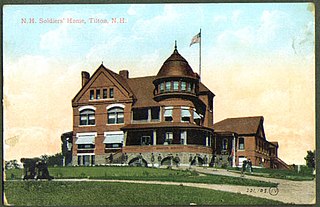
An old soldiers' home is a military veterans' retirement home, nursing home, or hospital, or sometimes an institution for the care of the widows and orphans of a nation's soldiers, sailors, and marines, etc.
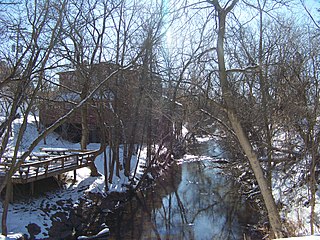
The Chenango Canal was a towpath canal in central New York in the United States which linked the Susquehanna River to the Erie Canal. Built and operated in the mid-19th century, it was 97 miles long and for much of its course followed the Chenango River, along New York State Route 12 from Binghamton on the south end to Utica on the north. It operated from 1834 to 1878 and provided a significant link in the water transportation system of the northeastern U.S. until supplanted by the region's developing railroad network.
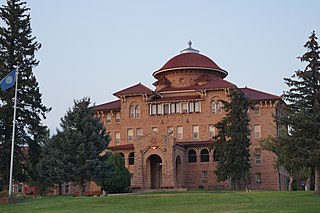
The National Asylum for Disabled Volunteer Soldiers was established on March 3, 1865, in the United States by Congress to provide care for volunteer soldiers who had been disabled through loss of limb, wounds, disease, or injury during service in the Union forces in the American Civil War. Initially, the Asylum, later called the Home, was planned to have three branches: in the Northeast, in the central area north of the Ohio River, and in what was then considered the Northwest, the present upper Midwest.

The United States Sanitary Commission (USSC) was a private relief agency created by federal legislation on June 18, 1861, to support sick and wounded soldiers of the United States Army during the American Civil War. It operated across the North, raised an estimated $25 million in Civil War era revenue and in-kind contributions to support the cause, and enlisted thousands of volunteers. The president was Henry Whitney Bellows, and Frederick Law Olmsted acted as executive secretary. It was modeled on the British Sanitary Commission, set up during the Crimean War (1853-1856), and from the British parliamentary report published after the Indian Rebellion of 1857.

The Armed Forces Retirement Home refers to one of two facilities, one in Gulfport, Mississippi, the other in Washington, D.C., that house veterans and active duty members of the United States Armed Forces.

The Commonwealth of Massachusetts played a significant role in national events prior to and during the American Civil War (1861-1865). Massachusetts dominated the early antislavery movement during the 1830s, motivating activists across the nation. This, in turn, increased sectionalism in the North and South, one of the factors that led to the war. Politicians from Massachusetts, echoing the views of social activists, further increased national tensions. The state was dominated by the Republican Party and was also home to many Radical Republican leaders who promoted harsh treatment of slave owners and, later, the former civilian leaders of the Confederate States of America and the military officers in the Confederate States Army.

New York State Route 220 (NY 220) is a 20.81-mile-long (33.49 km) state highway located in Chenango County, New York, in the United States. It is signed as an east–west highway, but its actual routing wanders considerably from north to south as it proceeds across the county. The western terminus of NY 220 is at an intersection with NY 41 near the western county line in the town of Smithville. Its eastern terminus is in the town of Oxford, where it becomes County Route 32 (CR 32) east of the village of Oxford. The stub of NY 220 east of Oxford serves as a signed connection between NY 12 and the New York State Veterans' Home at Oxford located east of the village along the Chenango River.

Lansdowne Christian Church was established in 1903 in Lansdowne, Maryland. Part of the Christian Church denomination, Lansdowne Christian Church is located at 101 Clyde Avenue, Lansdowne, Baltimore, Maryland 21227 in southwest Baltimore County, on the southwestern outskirts of the City of Baltimore. Rev. J. B. DeHoff was the first pastor in the early 20th century. The church is currently led by the Rev. Trent Owings.

Sarah "Annie" Turner Wittenmyer was an American social reformer, relief worker, and writer. She served as the first President of the Women's Christian Temperance Union from 1874 to 1879. The Iowa Soldiers' Orphans' Home was renamed the Annie Wittenmyer Home in 1949 in her honor.
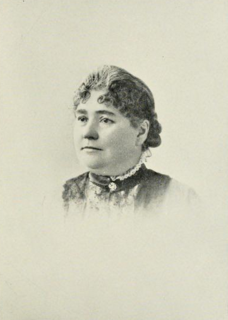
The Woman's Relief Corps (WRC) is a charitable organization in the United States, originally founded as the official women's auxiliary to the Grand Army of the Republic (GAR) in 1883. The organization was designed to assist the GAR and provide post-war relief to Union veterans. The GAR had been created as a "fraternal" organization and refused to allow women to join up until the creation of this auxiliary. It is largely dedicated to historical preservation of research and official documentation related to the WRC and GAR.

Mary Jewett Telford was a humanitarian who worked as a nurse at Hospital No. 8 in Nashville, Tennessee, during the American Civil War. In her later years, Mary was a published author, editor of numerous journals, lecturer on the temperance circuit and charter member of the Woman's Relief Corps, an auxiliary to the Grand Army of the Republic.

The Stephenson Grand Army of the Republic Memorial, also known as Dr. Benjamin F. Stephenson, is a public artwork in Washington, D.C. honoring Dr. Benjamin F. Stephenson, founder of the Grand Army of the Republic, a fraternal organization for Union veterans. The memorial is sited at Indiana Plaza, located at the intersection of 7th Street, Indiana Avenue, and Pennsylvania Avenue NW in the Penn Quarter neighborhood. The bronze figures were sculpted by J. Massey Rhind, a prominent 20th-century artist. Attendees at the 1909 dedication ceremony included President William Howard Taft, Senator William Warner, and hundreds of Union veterans.

Margaret Ray Wickens was an American public affairs organizer and social reformer. She served as national president of the Woman's Relief Corps (W.R.C.). Eloquent, Wickins was called the "Golden-tongued orator of the Woman's Relief Corps". Her executive abilities during the years that she was actively engaged in W.R.C. advanced the organization's patriotic work. As an orator, philanthropist and industrial worker, Wickens had no peer. She served as president of the Kansas State Assembly of Rebekahs, and was active in the temperance movement, filling the role of district president of her Woman's Christian Temperance Union (W.C.T.U.) for several years. She was a teacher, a member of the Daughters of the American Revolution, and a prominent Good Templar. In her later years, she held a number of state positions in Illinois.
References
- ↑ "Women's Relief Corps" in Veterans' Home at Oxford" at http://www.nysvets.org/homes/oxford/wrc/ (accessed 7 April 2010).
- ↑ "Our History" in Veterans' Home at Oxford" at http://www.nysvets.org/homes/oxford/history.aspx (accessed 7 April 2010).
- ↑ "Veterans' Home at Oxford" at http://www.nysvets.org/homes/oxford/ (accessed 8 April 2010).
Coordinates: 42°26′51″N75°34′36″W / 42.447618°N 75.576648°W